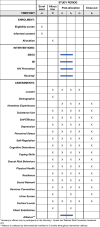Housing, opportunities, motivation and engagement (HOME) for homeless youth at-risk for opioid use disorder: study protocol for a randomized controlled trial
- PMID: 33980315
- PMCID: PMC8115873
- DOI: 10.1186/s13722-021-00237-7
Housing, opportunities, motivation and engagement (HOME) for homeless youth at-risk for opioid use disorder: study protocol for a randomized controlled trial
Abstract
Background: Homeless youth experience high rates of substance use disorders, exposures to violence, mental and physical health conditions, and mortality. They have been particularly affected by the opioid crisis. However, no study to date has used a randomized controlled design to test preventive interventions of opioid and other drug use among this vulnerable population. Resolution of youth homelessness through housing and supportive services including prevention services, often referred to as "Housing First," has great potential to reduce the likelihood for the development of an opioid use disorder as well as other problem behaviors associated with living on the streets. Housing First has been tested through randomized trials among homeless adults with mental health and substance use disorders, but has not been empirically tested for opioid prevention among homeless youth.
Methods: Homeless youth will be recruited from a drop-in shelter site frequented by disconnected youth; they will be screened for eligibility, including current homelessness, age 18-24 years, and not currently meeting criteria for opioid use disorder (OUD). In a controlled trial, 240 youth will then be randomized to one of two conditions, (1) housing + opioid and related risk prevention services, or (2) opioid and related risk prevention services alone. This project utilizes existing efficacious models of prevention to address opioid-related risks, including motivational interviewing, strengths-based outreach and advocacy, and an HIV risk preventive intervention. Follow-up will be conducted at 3, 6, 9 and 12-months post-baseline. The economic cost of each intervention will be determined to support implementation decisions with other providers and their funders.
Discussion: This study will provide essential information for researchers and providers on the efficacy of housing + opioid and related risk prevention services in an RCT for effects on opioid use and mechanisms underlying change. Because youth experiencing homelessness are at increased risk for a variety of adverse outcomes, the proposed intervention may produce substantial health care benefits to the youths and society at large. Trial registration ClinicalTrials.gov, NCT04135703, Registered October 13, 2019, https://clinicaltrials.gov/ct2/show/NCT04135703?term=NCT04135703&draw=2&rank=1#contacts.
Keywords: Homelessness; Housing First; Opioid use disorder; Prevention.
Conflict of interest statement
The authors declare that they have no competing interests.
Figures

Similar articles
-
Housing First Combined with Suicide Treatment Education and Prevention (HOME + STEP): study protocol for a randomized controlled trial.BMC Public Health. 2021 Jun 12;21(1):1128. doi: 10.1186/s12889-021-11133-9. BMC Public Health. 2021. PMID: 34118916 Free PMC article.
-
"Prevention of opioid use disorder: the HOME (housing, opportunities, motivation and engagement) feasibility study".Harm Reduct J. 2021 Nov 8;18(1):112. doi: 10.1186/s12954-021-00560-x. Harm Reduct J. 2021. PMID: 34749744 Free PMC article.
-
A Rent Subsidy and Identity Capital Intervention for Youth Exiting Homelessness: Protocol for the Transitioning Youth Out of Homelessness 2.0 Pilot Randomized Controlled Trial.JMIR Res Protoc. 2025 Apr 25;14:e66210. doi: 10.2196/66210. JMIR Res Protoc. 2025. PMID: 40279147 Free PMC article.
-
The impact of interventions for youth experiencing homelessness on housing, mental health, substance use, and family cohesion: a systematic review.BMC Public Health. 2019 Nov 14;19(1):1528. doi: 10.1186/s12889-019-7856-0. BMC Public Health. 2019. PMID: 31727031 Free PMC article.
-
Addressing Intersecting Social and Mental Health Needs Among Transition-Age Homeless Youths: A Review of the Literature.Psychiatr Serv. 2021 Mar 1;72(3):317-324. doi: 10.1176/appi.ps.201900498. Epub 2021 Jan 5. Psychiatr Serv. 2021. PMID: 33397145 Free PMC article. Review.
Cited by
-
Housing First Combined with Suicide Treatment Education and Prevention (HOME + STEP): study protocol for a randomized controlled trial.BMC Public Health. 2021 Jun 12;21(1):1128. doi: 10.1186/s12889-021-11133-9. BMC Public Health. 2021. PMID: 34118916 Free PMC article.
-
Application of the ecobiodevelopmental model for research among youth experiencing homelessness.Public Health Nurs. 2023 Jul-Aug;40(4):543-549. doi: 10.1111/phn.13183. Epub 2023 Mar 6. Public Health Nurs. 2023. PMID: 36880176 Free PMC article.
-
Sex differences in poly-victimization among youth experiencing homelessness prior to substance use treatment.Child Abuse Negl. 2022 Jul;129:105670. doi: 10.1016/j.chiabu.2022.105670. Epub 2022 May 12. Child Abuse Negl. 2022. PMID: 35569181 Free PMC article.
-
Longitudinal Associations between Homelessness and Substance Use: Investigating Demographic Differences for Young Adults in Treatment.Subst Use Misuse. 2024;59(2):243-253. doi: 10.1080/10826084.2023.2267124. Epub 2023 Dec 28. Subst Use Misuse. 2024. PMID: 37897085 Free PMC article.
-
Interventions for prevention and treatment of substance use in youth with traumatic childhood experiences: a systematic review and synthesis of the literature.Eur Child Adolesc Psychiatry. 2024 Oct;33(10):3419-3438. doi: 10.1007/s00787-023-02265-x. Epub 2023 Jul 22. Eur Child Adolesc Psychiatry. 2024. PMID: 37480386
References
-
- Brands B, Leslie K, Catz-Biro L, Li S. Heroin use and barriers to treatment in street-involved youth. Addict Res Theory. 2005;13(5):477–487. doi: 10.1080/16066350500150624. - DOI
Publication types
MeSH terms
Associated data
Grants and funding
LinkOut - more resources
Full Text Sources
Other Literature Sources
Medical

